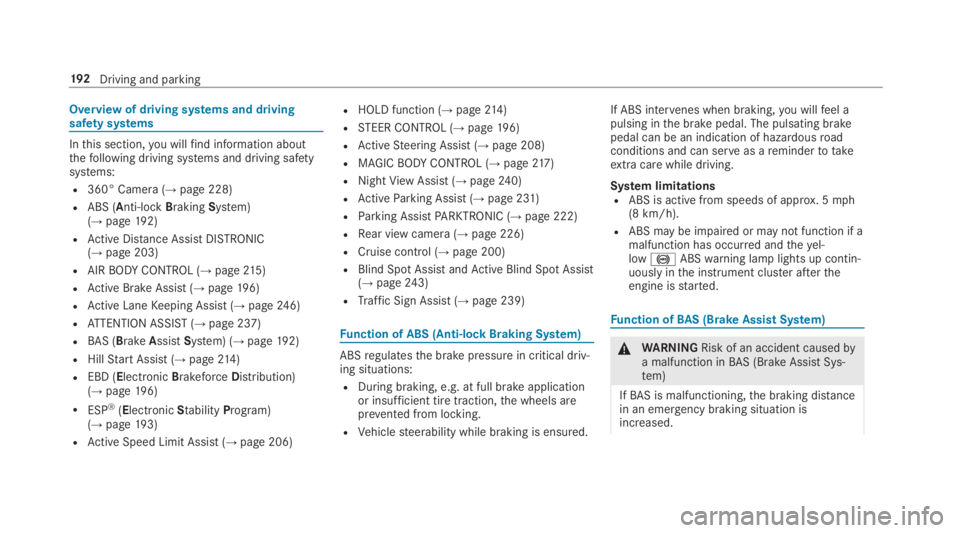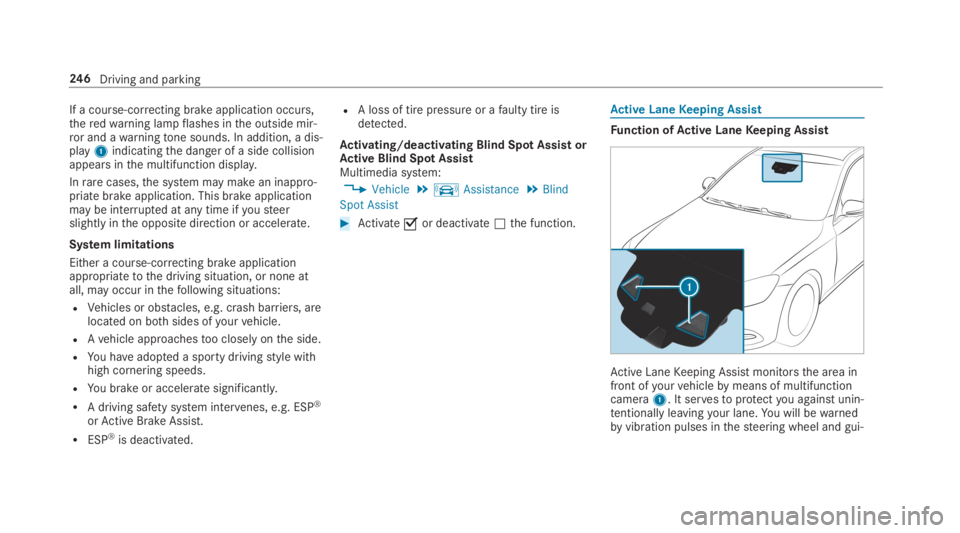2019 MERCEDES-BENZ S CLASS tire pressure
[x] Cancel search: tire pressurePage 6 of 578

Wheels and tires......................................434Notes on noise or unusual handlingchar‐acteristics ...................................................434Notes onregularlyinspecting wheels andtires ............................................................ 434Notes on snowchains ................................ 435Tirepressure .............................................. 435Loadingthevehicle ....................................442Tirelabeling ................................................446Definition oftermsfor tires and loading ..... 451Changing a wheel ....................................... 454
Technical data..........................................464Notes ontechnical data.............................. 464Vehicle electronics .....................................464Vehicle identification plate, VIN andengine numberoverview ............................ 466Operatingfluids .......................................... 468Vehicle data ................................................475
Display messages andwarning/indi‐cator lamps...............................................478Displaymessages .......................................478Warning and indicator lamps ...................... 523
Index.........................................................536
4Contents
Page 19 of 578

Whattodo intheevent of an accident
1QR codesfor accessingtherescue card→26
2Safetyvests→413
3Buttonfor SOS emergency call system→346
4Checking andtopping up operatingfluids→468
5Tow-starting andtowingaway→426
6Flat tire→413
7Starting assistance→423
8Hazardwarning lights→147
9Fuelfillerflap with instruction labelsfor tirepressure, fuel type and QR codesfor access‐ingtherescue card
→180
ATow-starting andtowingaway→426
BTIREFIT kit→41 5
Ataglance – Emergencies and breakdowns17
Page 21 of 578

Protectingthe environment
Plug-inhybrid:observethe notes inthe Supple‐ment. Otherwise,you mayfailtorecognize dan‐gers.
+ENVIRONMENTALNOTEEnvironmentaldamageduetooperating conditions andpersonal drivingstyle
The pollutant emission ofyourvehicle isdirectlyrelatedtothewayyou operateyourvehicle.
Helptoprotectthe environmentbyoperatingyourvehicle in an environmentallyresponsi‐ble manner. Please observethefollowingrec‐ommendations on operating conditions andpersonal drivingstyle.
Operating conditions:
#Make surethatthe tire pressure is cor‐rect.
#Do not carryany unnecessaryweight(e.g.roof luggageracks onceyou nolonger needthem).
#Adheretothe service intervals.Aregularly servicedvehicle will contrib‐utetoenvironmental protection.
#Always havemaintenanceworkcarriedout at aqualified specialistworkshop.
Personal drivingstyle:
#Do not depressthe accelerator pedalwhenstartingthe engine.
#Do notwarmupthe engine whilethevehicle isstationary.
#Drive carefully and maintain a suitabledistance fromthevehicle in front.
#Avoid frequent, sudden accelerationand braking.
#Changegear in good time and use eachgear onlyupto�
Page 28 of 578

QR codeforrescue card
The QR code is secured inthe fuelfillerflap andonthe opposite side onthe B-pillar. Intheeventof an accident,rescue services can usethe QRcodetoquicklyfindthe appropriaterescue cardforyourvehicle. The currentrescue card con‐tainsthe most important information aboutyourvehicle in a compactform, e.g.therouting oftheelectric lines.
Further information can be obtained at http://www.mercedes-benz.de/qr-code.
Datastorage
Electronic control units
Electronic control units are installed inyourvehi‐cle. Some ofthese are necessaryforthe safeoperation ofyourvehicle, while some assistyouwhen driving (driver assistance systems). Inaddition,yourvehicle provides comfortandentertainment functions, which are also madepossiblebyelectronic control units.
Electronic control units contain datamemorieswhichcantemporarily or permanentlystore
technical information aboutthevehicle's operat‐ingstate, component loads, maintenancerequirements andtechnicalevents or malfunc‐tions.
Ingeneral,this information documentsthestateof a component part, a module, a system orthesurroundings such as:
Roperatingstatus of system components (e.g.fill levels, batterystatus, tire pressure)
Rstatus messages concerningthevehicle orits individual components (e.g. number ofwheelrevolutions/speed, longitudinal accel‐eration, lateral acceleration, display offas‐tened seat belts)
Rmalfunctions orfaults in important systemcomponents (e.g. lights, brakes)
Rinformation onevents leadingtovehicledamage
Rsystemreactions in special driving situations(e.g. airbag deployment, intervention ofsta‐bility control systems)
Rambient conditions (e.g.temperature,rainsensor)
In additiontoprovidingthe actual control unitfunction,this data assiststhe manufacturer indetecting andrectifying malfunctions and opti‐mizingvehicle functions. The majority ofthisdata istemporary and is only processed inthevehicle itself. Only a small portion ofthe data isstored intheevent or malfunction memory.
Whenyourvehicle is serviced,technical datafromthevehicle can beread outbyservice net‐workemployees (e.g.workshops, manufactur‐ers) orthird parties (e.g. breakdown services).Services includerepair services, maintenanceprocesses,warranty claims andquality assur‐ance measures,forexample. Theread out is per‐formed viathe legally prescribed portforthediagnostics connection inthevehicle. Therespective service network locations orthirdparties collect, process and usethe data. Theydocumenttechnicalstatuses ofthevehicle,assist infinding malfunctions and improvingquality and are transmittedtothe manufacturer,if necessary.Furthermore,the manufacturer issubjecttoproduct liability.Forthis,the manu‐facturerrequirestechnical datafromvehicles.
26General notes
Page 184 of 578

#Havethe fueltank and fuel linesdrained completely.
*NOTEDamagetothe fuel system causedbyoverfilled fueltanks.
#Onlyfillthe fueltank untilthe pumpnozzle switches off.
*NOTEFuel may sprayout whenyouremovethe fuel pump nozzle.
#Onlyfillthe fueltank untilthe pumpnozzle switches off.
Requirements:RThevehicle is unlocked.
%Do notget intothevehicle again duringtherefueling process. Otherwise, electrostaticchargecould build up again.
Observethe notes on operatingfluids(→page 468).
Plug-inhybrid:observethe notes inthe Supple‐ment. Otherwise,you mayfailtorecognize dan‐gers.
1Fuelfillerflap
2Bracketforthe fuelfiller cap
3Tirepressuretable
4QR codeforrescue card
5Fuel type
#Press fuelfillerflap1.
#Turnthe fuelfiller cap counter-clockwise andremoveit.
#Insertthe fuelfiller cap into bracket2.
#Completelyinsertthe pump nozzle intothetankfiller neck,hook in place andrefuel.
#Onlyfillthetank untilthe pump nozzleswitches off.
#Replacethe cap onthefiller neck and turnclockwise until it engages audibly.
#Closethe fuelfillerflap.
Parking
Parkingthevehicle
&WARNINGRisk offirecausedbyhotexhaust system parts
Flammable material such as leaves, grass ortwigs may ignite iftheycome into contactwithhot parts oftheexhaust system orexhaustgasflow.
18 2Driving and parking
Page 194 of 578

Overview of driving systems and drivingsafety systems
Inthis section,you willfind information aboutthefollowing driving systems and driving safetysystems:
R360° Camera (→page 228)
RABS (Anti-lockBrakingSystem)(→page192)
RActive Distance AssistDISTRONIC(→page203)
RAIRBODYCONTROL (→page215)
RActive Brake Assist (→page196)
RActive LaneKeeping Assist (→page246)
RATTENTION ASSIST (→page 237)
RBAS (BrakeAssistSystem) (→page192)
RHillStart Assist (→page214)
REBD (ElectronicBrakeforceDistribution)(→page196)
RESP®(ElectronicStabilityProgram)(→page193)
RActive Speed Limit Assist (→page 206)
RHOLD function (→page214)
RSTEER CONTROL (→page196)
RActiveSteering Assist (→page 208)
RMAGICBODYCONTROL (→page217)
RNightViewAssist (→page240)
RActiveParking Assist (→page 231)
RParking AssistPARKTRONIC (→page 222)
RRear view camera (→page 226)
RCruise control (→page 200)
RBlind Spot Assist andActive Blind Spot Assist(→page243)
RTraffic Sign Assist (→page 239)
Function of ABS (Anti-lock Braking System)
ABSregulatesthe brake pressure in critical driv‐ing situations:
RDuring braking, e.g. at full brake applicationor insufficient tire traction,the wheels areprevented from locking.
RVehiclesteerability while braking is ensured.
If ABS intervenes when braking,you willfeel apulsing inthe brake pedal. The pulsating brakepedal can be an indication of hazardousroadconditions and can serveas aremindertotakeextra care while driving.
System limitationsRABS is active from speeds of approx. 5mph(8 km/h).
RABS may be impaired or may not function if amalfunction has occurred andtheyel‐low�%ABSwarning lamp lights up contin‐uously inthe instrument cluster aftertheengine isstarted.
Function ofBAS (Brake Assist System)
&WARNINGRisk of an accident causedbya malfunction inBAS (Brake AssistSys‐tem)
IfBAS is malfunctioning,the braking distancein an emergency braking situation isincreased.
19 2Driving and parking
Page 202 of 578

RIfthe sensors malfunction dueto otherradarsource interference,forexamplestrongradarreflections in parkinggarages.
RIf a loss of tire pressure or a defective tirehas been detected and displayed.
The system may notreact correctly:
RIn complextraffic situations whereobjectscannotalways be clearly identified.
RTopedestrians orvehicles iftheymovequickly intothe sensor detectionrange.
RTopedestrians who are hiddenby otherobjects.
RIfthe typical outline of a pedestrian cannotbe distinguished fromthe background.
RIf a pedestrian is notrecognized as such, e.g.duetospecial clothing orother objects.
ROn bends with a tightradius.
SettingActive Brake Assist
Multimedia system:
,Vehicle.kAssistance.Active
Brake Assist
Vehicles without Driving AssistancePack‐age:The settings can be made afterstartingthevehicle.
Vehicles with Driving AssistancePackage:The settings can be made whenthe ignition isswitched on.
Thefollowing settings areavailable:
REarly
RMedium
RLate
#Select a setting.
%Your selection isretained whenthevehicle isnextstarted.
DeactivatingActive Brake Assist
%It isrecommendedthatyou always leaveActive Brake Assistactivated.
#SelectOff.The distancewarning function andthe auton‐omous braking function are deactivated.
Vehicles without Driving AssistancePack‐age:Whenthevehicle is nextstarted,themedium setting is automatically selected.
Vehicles with Driving AssistancePack‐age:EvasiveSteering Assist is notavailable.Whenthe ignition is nextstarted,themedium setting is selected automaticallyandEvasiveSteering Assist isavailable.
%IfActive Brake Assistis deactivated,the�
Page 248 of 578

If a course-correcting brake application occurs,theredwarning lampflashes inthe outside mir‐ror and awarningtone sounds. In addition, a dis‐play1indicatingthe danger of a side collisionappears inthe multifunction display.
Inrarecases,the system may make an inappro‐priate brake application. This brake applicationmay be interrupted at any time ifyousteerslightly inthe opposite direction or accelerate.
System limitations
Either a course-correcting brake applicationappropriatetothe driving situation, or none atall, may occur inthefollowing situations:
RVehicles or obstacles, e.g. crash barriers, arelocated on bothsides ofyourvehicle.
RAvehicle approachestoo closely onthe side.
RYou haveadopted a sporty drivingstyle withhigh cornering speeds.
RYou brake or accelerate significantly.
RA driving safety system intervenes, e.g. ESP®
orActive Brake Assist.
RESP®is deactivated.
RA loss of tire pressure or afaulty tire isdetected.
Activating/deactivating Blind Spot AssistorActive Blind Spot AssistMultimedia system:
,Vehicle.kAssistance.Blind
Spot Assist
#Activate�sor deactivate�Sthe function.
Active LaneKeeping Assist
Function ofActive LaneKeeping Assist
Active LaneKeeping Assist monitorsthe area infront ofyourvehiclebymeans of multifunctioncamera1. It servestoprotectyou against unin‐tentionallyleavingyour lane.You will bewarnedbyvibration pulses inthesteering wheel and gui‐
246Driving and parking